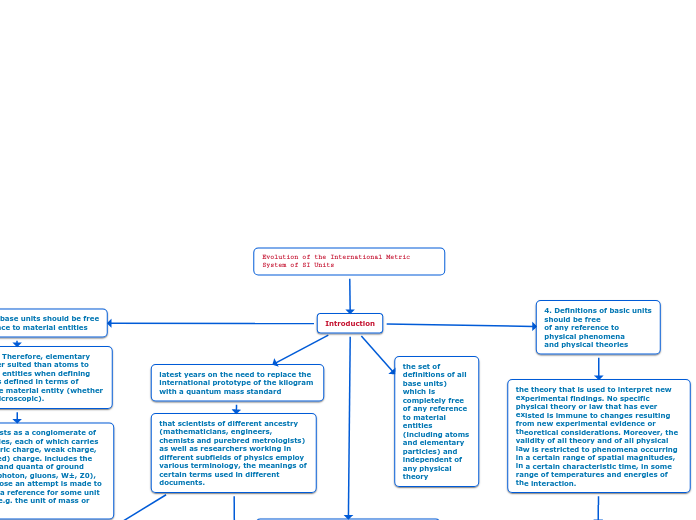6. Discussion comprehensive view on the evolutionof the international system of units
The international metric system of units came into being with the signing of the Metric Convention in 1875, which sanctioned the international standards of mass and length in the form of artifacts. The international prototypes of the kilogram and the meter were deposited at the BIPM; their copies were prepared, selected and distributed among the participating states at the end of 1889.
Evolution of the International Metric System of SI Units
Introduction
4. Definitions of basic units should be free
of any reference to physical phenomena
and physical theories
the theory that is used to interpret new experimental findings. No specific physical theory or law that has ever existed is immune to changes resulting from new experimental evidence or theoretical considerations. Moreover, the validity of all theory and of all physical law is restricted to phenomena occurring in a certain range of spatial magnitudes, in a certain characteristic time, in some range of temperatures and energies of the interaction.
the theory that is used to interpret new experimental findings. No specific physical theory or law that has ever existed is immune to changes resulting from new experimental evidence or theoretical considerations. In addition, the validity of all theory and of all physical law is restricted to phenomena that occur in a certain range of spatial magnitudes, in a certain characteristic time, in some range of temperatures and energies of the interaction.
3. Definitions of base units should be free
from any reference to material entities
mentioned above. Therefore, elementary particles are better suited than atoms to become reference entities when defining units or if a unit is defined in terms of properties of some material entity (whether macroscopic or microscopic).
the proton manifests as a conglomerate of constituent particles, each of which carries its fractional electric charge, weak charge, and strong (colored) charge. includes the electron), quarks and quanta of ground interactions (the photon, gluons, W±, Z0), see, p. [25]. Suppose an attempt is made to use the proton as a reference for some unit of measurement, e.g. the unit of mass or electric charge.
2. Maxwell's idea of atomic standards
as an engine of the contemporary
and future evolution of the system of units
As physics and other natural sciences advance, our opinions about what is absolute vary accordingly. Instead, he proposed basing the system of units on atomic patterns that he considered absolute in the sense of atoms being identical and immutable,
Elementary particles are not only less complex than atoms and molecules, but they are also much less vulnerable to external influences, because much higher energies are required to affect their properties.
the set of definitions of all base units) which is completely free of any reference to material entities (including atoms and elementary particles) and independent of any physical theory
latest years on the need to replace the international prototype of the kilogram with a quantum mass standard
that scientists of different ancestry (mathematicians, engineers, chemists and purebred metrologists) as well as researchers working in different subfields of physics employ various terminology, the meanings of certain terms used in different documents.
(1) in general, mass is the element of the spacetime metric, so that mass and gravity are associated with global properties of spacetime, while charges are essentially local notions. (2) mass changes continuously in the special relativistic realm, while electric charge (and other charges) are velocity-independent, since they are Lorentz invariants. (3) mass is the element of covariant and contravariant quantities (eg, energy-momentum vector, energy-stress tensor) that transform very differently from charges, which are true scalars. (4) the gravitational interaction can be quantized (for now), while the electric charge, the weak charge and the strong charge are intrinsically quantized entities and their interactions have quantum nature.
Temperature characterizes the average thermal energy of particles in a certain set of particles in the state of thermodynamic equilibrium. Therefore, in principle, this quantity could be expressed in terms of the unit of energy, kg m2s−2; this is practiced in many fields of physics, especially statistical physics, where it is quite common to use Θ = kBT (see, for example, sect. 5.3, p. 99 in [34]) or β = 1/kBT (see e.g. Second, temperature deserves its “proper” unit because it is one of the most important and most frequently measured variables (or parameters, depending on the situation [34, 35]) as a measure of thermal energy, rather than thermal energy. temperature T measured in kelvins.
5. The system of units where all base units
are defined exclusively
in terms of physical constants ubtopic
A) correspond to all fundamental notions of physics (i.e., and indefinable, such as time, length, mass, and‡ Currently, the most accurate measurements of the current use of the Josephson effect and the quantum Hall effect, rather than the defining realization of the ampere. Evolution of the International Metric System of Units SI 1003quantified charges), in terms of which all other observable quantities can be expressed, at least in principle; pic
B) they can be defined exclusively in terms of fundamental physical constants, i.e. c, h, G and coupling constants of quantified interactions
C) Physical quantities can be expressed in terms of time, length, mass and charges, their numerical values can, in principle, be expressed exclusively in terms of fundamental base units (the second, the meter, the kilogram and the units of quantified charges), although other units can be entered for the convenience of users.
D) the number of fundamental basic units cannot be reduced without compromising the uniqueness of their physical meaning









